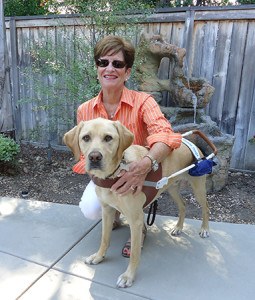Going with a guide dog
Sometimes the greatest of all mobility tools is not a tool at all. Perhaps its a furry friend. While taking care of a service-canine companion requires way more time and effort than taking care of a mobility cane, the payback in both love and freedom can be immeasurable.

Adam Lawrence was diagnosed with retinitis pigmentosa (RP) at age 17. Now 55 and legally blind, he has come to depend on his guide dog, a black and tan Labrador named Escort. Escort gives me confidence, Lawrence says. When I walk with a cane, I don’t feel as confident, and I’m much slower. He gives me confidence, mobility and ability.
Lawrence hadn’t planned to get a guide dog. Two months after his beloved pet dog died, he and his wife were at a fundraising event, when they came upon a table staffed by Guide Dogs of America. They had a chocolate Lab puppy on the table he says with a smile. They put my hand on the puppy, and there was no turning back. Lawrence completed an intensive, month-long, on-site orientation, during which he was paired with Escort the best dog in the world.
Now in their sixth year as a team, Lawrence and Escort travel extensively. We’ve even gone rock-climbing, which was amazing. On the way down, Escort chose the more difficult path for himself, and left the easier path for me. He’s amazing.
When I’m with Escort, I have freedom. I’m not tethered to a person’s elbow, Lawrence says. But he is not a GPS; I have to plan and know where we are going. He’s there to keep me safe; he’s not there to figure out where to go that’s my job.

Linda Becker echoes that sentiment. You find your way home by feeling the surfaces beneath your feet. You learn the distances to the places you go. You localize sounds associated with places. All these things you learn come together, and you pass it on to your dog. You have to know how to get from A to B, so you can teach your dog those places. You are in control.
Diagnosed with RP 30 years ago, Becker was encouraged to get a guide dog by her children. I knew nothing about them, she admits. I called Guide Dogs for the Blind (GDB). I found out the dogs are free and that I needed orientation and mobility (O&M) skills before I could be considered.
Becker set about developing her skills at the Braille Institute, including walking with a white cane. She successfully completed the requirement of walking one mile to and from her home with the cane, and then two weeks of on-site training at GDB’s campus in Oregon, where she was paired with Lyla, a yellow English Lab.
Becker and Lyla started traveling on behalf of various vision organizations, including GDB. I was a speaker here, an ambassador there, Becker says. We started hopping on planes, going to hotels, asking questions, figuring things out.
When Lyla retired (living out the rest of her life with the Becker family as a pampered pet), Becker was paired with Anchorage, a yellow Lab, who is also a great traveler. He is fabulous on a flight. He is at my feet, while I’m in my seat. Knowing he’s there and petting him he gives me courage, she says.
When the pair arrives at a hotel, Becker asks for a room near the elevator or ice-maker, which offer landmarks and sensory cues. She also asks a hotel employee to show them to their room once. After that, when they exit the elevator, Becker says something, such as, Left, find room, and Anchorage leads the way.
Becker and her dogs have been on numerous cruises, where navigating big ships can be confusing for anyone. Other passengers with rooms nearby sighted passengers always follow me and the dog, so they can find their rooms, she says.
Both Becker and Lawrence stress the importance of planning and organization when it comes to traveling with their dogs. Among their advice: Plan as much as possible, leave plenty of extra time, know where you’re going, don’t be afraid to ask for help, and be flexible.
They also point out that working dogs need downtime. A guide dog is not a cane. He’s not just a tool he’s your dog and your companion, Lawrence says. Escort is a different dog when the [working] harness is on. When I call him, if he is not in his harness, he may not come quite as quickly, since he is off duty. If the harness is on, he’ll be there in a second. He knows he is working.
Becker emphasizes the importance of playing with the dog when he or she is off-duty. They must be safe and taken care of, so they can care for you, she says. We take care of each other.

